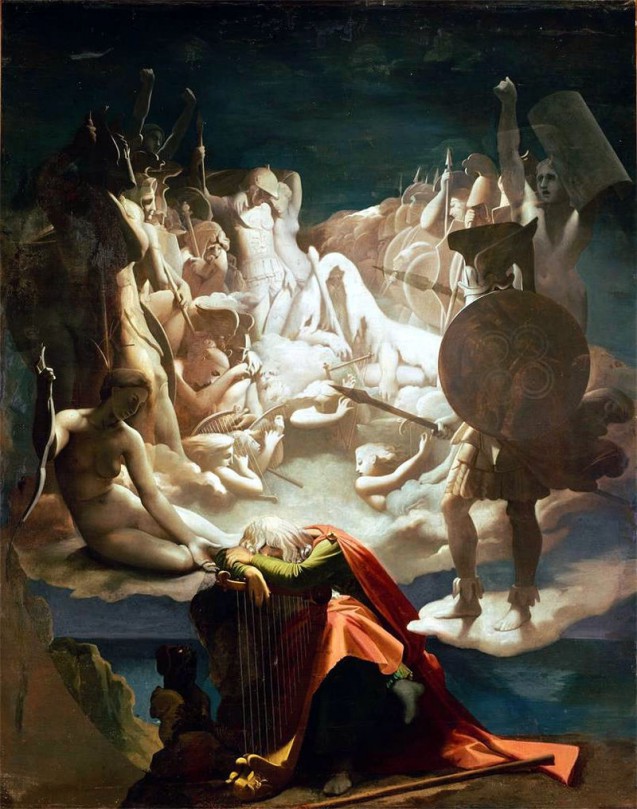In August 1797, the future Grand Master of the Imperial University, Jean-Pierre-Louis de Fontanes, wrote a letter praising the young general Bonaparte to the skies. “It is said”, he enthused, “that you always have a copy of Ossian in your pocket – even in the midst of battles”. The sixteen-year-old Lamartine wrote of his own coming of age in 1806, calling those years “the time when Ossian […] ruled the imagination of France”. The painter/art critic Etienne-Jean Delécluze, Jacques-Louis David’s favourite pupil, noted in his memoirs that in the years following the First Italian Campaign it had been Bonaparte himself who spread the mania for Ossian in France. But who was Ossian? The Scottish writer James MacPherson claimed that he had “rediscovered” and translated mysterious Gaelic poems into English in 1762-3 by a certain Ossian, a third century AD warrior-bard, hardly spoken of today. His adventures and those of his father Fingal, the King of Morven brought massive acclaim to Macpherson in Britain, and the enthusiasm quickly spread to Europe via translations, such as that of Letourneur in France in 1777 (presumably the one that Napoleon had in his back pocket). Because of Napoleon’s love for the poems, Ossian even ousted the great poets of classical antiquity from the summit of Parnassus. The poet Nepomucène Lemercier reported that in 1800 Bonaparte had adopted Ossian as HIS poet since Homer and Virgil were already taken (by Alexander and Augustus respectively!). In the same year, a medallion portrait of Ossian was affixed to the wall of the library at Malmaison and the following year Ossianic paintings were commissioned from Gérard and Girodet for the salon doré of that same chateau. To cap it all, Lesueur was to compose the opera Ossian ou les Bardes, dedicated to the Premier Consul in 1803 and Napoleon and Josephine were at the premier in 1804 – after which Napoleon is said to have unpinned his Légion d’Honneur and stuck it on the composer! Napoleon’s love was to last right until the years of exile, for Maitland spotted Ossian amongst Napoleon’s books on Bellerophon. Nor did the discovery in 1805 that the Ossian poems had largely been invented by MacPherson himself (it was said that he had arranged and completed the original fragments), douse in any way enthusiasm for all things Caledonian. Indeed, Ossian mania continued to provide a refreshing alternative to Greco-Roman antiquity which had until then had been the dominant historical and indeed mythological reference in Europe.
In 1811, Ingres was commissioned to paint “Le Songe d’Ossian” for the ceiling of Napoleon’s bedroom at the Palais Quirinal (at that time being fitted out to become the King of Rome’s palace). His Ossian naturally paid homage to earlier similarly themed work. In fact, Ingres’s composition is loosely based on Gerard’s “Ossian évoque les fantômes”. Furthermore, we know that Ingres possessed lithographs of Girodet’s painting and had made sketches of details from it. Here, the bard Ossian is seated in the foreground leaning on his harp, dreaming. He is backlit, and the light apparently comes from the group of ethereal creatures that occupy the upper two-thirds of the immense canvas. Ossian’s son, Oscar, who bears a sword and shield, stands to the right facing his mother, Evirallina. She is seated, holding a bow in one hand and reaching out towards her husband with the other. Behind her Ossian’s father, Fingal, leads a crowd of warriors some of whom are entwined with their naked lovers. In the centre, the long-haired figure of Starnos, the cruel Snow King, is seated behind four harpists evoking scenes from Lesueur’s opera. This evocation of the 1804 staging has led critics to think that Ingres was present at a performance of the work.
Alongside the Ossian, Ingres was also commissioned to paint for the Quirinal a Roman-themed “Romulus vainqueur d’Acron” (Romulus overcoming Acron) for Marie-Louise’s sitting room in the ex-papal palace. Both the Ossian and Romulus paintings were carefully planned (probably by Vivant Denon, director of the Napoléon Museum or Louvre) to fit their emplacements. A dream scene showing a young man accoutred for war facing his mother, against an epic Romantic backdrop, was naturally perfectly adapted to a bedroom. Likewise, the young Romulus in the act of military victory for the Empress’s salon matched other paintings commissioned for the palace with the baby King of Rome in mind, such as: “The Shepherd Faustulus bringing the young Romulus and Remus to Laurentia” and “France entrusting the young Napoleon to the city of Rome”. Both paintings (if ever installed) were removed on the fall of the Empire, the Pope having no place for this resolutely pagan art in his city residence – and twenty years later Ingres (who was then director of the Villa Médicis) bought the Ossian painting back from a Roman art dealer. Faced with the poor state of the painting, Ingres had it restored and greatly modified the composition [this squared-up drawing of 1813 shows the probable original composition, with Oscar positioned much futher back in the scene and Evirallina at his feet on the right as confirmed by the pentimenti in the painting such as the original sword and helmet of Oscar]. The work stands as an isolated reminder of how epic Scottish heros once rubbed shoulders with the founders of Rome…


